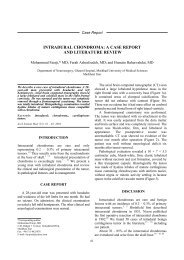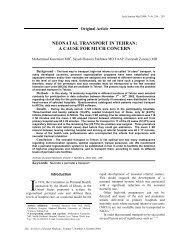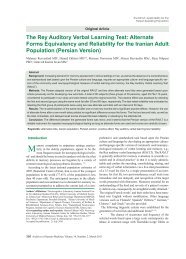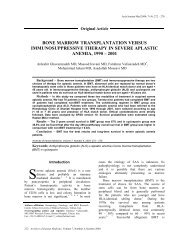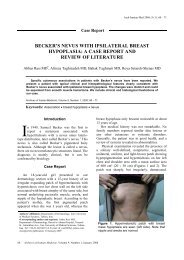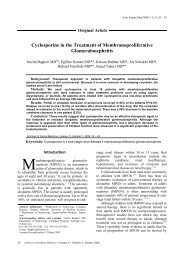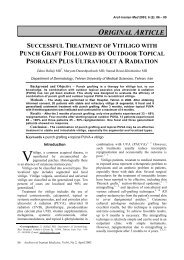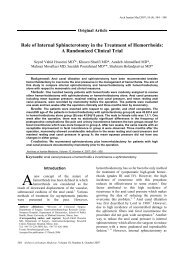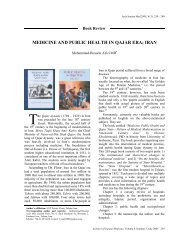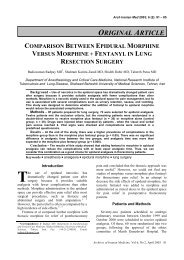a prospective study of etiology of short stature in 426 short children ...
a prospective study of etiology of short stature in 426 short children ...
a prospective study of etiology of short stature in 426 short children ...
You also want an ePaper? Increase the reach of your titles
YUMPU automatically turns print PDFs into web optimized ePapers that Google loves.
Orig<strong>in</strong>al Article<br />
A PROSPECTIVE STUDY OF ETIOLOGY OF SHORT STATURE<br />
IN <strong>426</strong> SHORT CHILDREN AND ADOLESCENTS<br />
Heshmat Moayeri,* MD; and Yahya Aghighi, MD<br />
Department <strong>of</strong> Pediatrics Endocr<strong>in</strong>ology, Imam Khome<strong>in</strong>i Hospital, Faculty <strong>of</strong> Medic<strong>in</strong>e,<br />
Tehran University <strong>of</strong> Medical Sciences, Tehran, Iran<br />
BACKGROUND—Short <strong>stature</strong> is def<strong>in</strong>ed as<br />
subnormal height relative to other <strong>children</strong> <strong>of</strong> the same<br />
sex and age, tak<strong>in</strong>g family <strong>in</strong>to consideration. This<br />
<strong>prospective</strong> <strong>study</strong> was designed <strong>in</strong> order to determ<strong>in</strong>e the<br />
etiologies <strong>of</strong> <strong>short</strong> <strong>stature</strong> with especial concern on the<br />
prevalence <strong>of</strong> growth hormone deficiency, and to<br />
compare the results with world-wide studies.<br />
MATERIALS AND METHODS—We studied <strong>426</strong><br />
subjects (272 boys and 154 girls) aged 4-18 years (mean,<br />
10.8 ± 4.8) with <strong>short</strong> <strong>stature</strong>. The decision to<br />
<strong>in</strong>vestigate the growth hormone axis was made with the<br />
knowledge that other explanations for growth failure<br />
have been excluded by documention <strong>of</strong> a normal full<br />
blood count, ESR, renal function, and measurement <strong>of</strong><br />
serum thyrox<strong>in</strong>e concentration. In some female<br />
subjects, a karyotype was performed to exclude Turner’s<br />
syndrome. Bone age was determ<strong>in</strong>ed <strong>in</strong> all subjects.<br />
RESULTS—Normal variants <strong>of</strong> growth <strong>in</strong>clud<strong>in</strong>g<br />
constitutional growth delay and familial <strong>short</strong> <strong>stature</strong><br />
were identified as the most common causes <strong>of</strong> growth<br />
failure <strong>in</strong> this <strong>study</strong>. The results obta<strong>in</strong>ed <strong>in</strong> this <strong>study</strong><br />
were <strong>in</strong> agreement with world-wide reports. Growth<br />
problems were more common <strong>in</strong> boys than <strong>in</strong> girls (1.8:<br />
1). Among the <strong>short</strong> subjects, 23.4% had classic growth<br />
hormone deficiency (GHD). Boys outnumbered girls 2:1<br />
(p < 0.05).<br />
CONCLUSION—We conclude that (1) most <strong>children</strong><br />
with <strong>short</strong> <strong>stature</strong> will not have an endocr<strong>in</strong>e disorder,<br />
but <strong>in</strong> endocr<strong>in</strong>e referral centers, the frequency <strong>of</strong> GHD<br />
is higher than <strong>in</strong> general cl<strong>in</strong>ics and (2) GHD appears<br />
to be more common <strong>in</strong> boys.<br />
Keywords: constitutional growth delay; familial <strong>short</strong><br />
<strong>stature</strong>; growth hormone deficiency; <strong>short</strong> <strong>stature</strong>.<br />
Arch Iranian Med. 7(1): 23 – 27; 2004<br />
factors. Normal growth can occur only if the<br />
<strong>in</strong>dividual is healthy. 1 L<strong>in</strong>ear growth is generally<br />
considered to be decreased when a child’s height falls<br />
more than 2 SD below the mean height for age, and<br />
when the patient’s l<strong>in</strong>ear growth velocity dim<strong>in</strong>ishes to<br />
less than 4 cm/yr (child’s growth shifts to a lower<br />
channel), or when the child is small for the<br />
midparental size. 2 – 5<br />
Health related causes <strong>of</strong> impaired l<strong>in</strong>ear growth<br />
<strong>in</strong>clude diverse systemic diseases, nutritional and<br />
emotional deprivation, endocr<strong>in</strong>e diseases and a<br />
wide range <strong>of</strong> dysmorphic syndromes, <strong>in</strong>born errors<br />
<strong>of</strong> metabolism, and chromosomal abnormalities. 5–7<br />
Variants <strong>of</strong> normal growth <strong>in</strong>clud<strong>in</strong>g constitutional<br />
growth delay (CGD) and familial <strong>short</strong> <strong>stature</strong><br />
(FSS) are the most common causes <strong>of</strong> <strong>short</strong><br />
1– 4, 6,7<br />
<strong>stature</strong>.<br />
The majority <strong>of</strong> studies on subjects with <strong>short</strong><br />
<strong>stature</strong> <strong>in</strong> Iran 8 – 10 <strong>in</strong>dicate that variants <strong>of</strong> normal<br />
growth are the most common causes, but few have<br />
considered the characteristics <strong>of</strong> patients with<br />
growth hormone deficiency. The aim <strong>of</strong> this <strong>study</strong><br />
was to determ<strong>in</strong>e the frequency <strong>of</strong> different causes<br />
<strong>of</strong> <strong>short</strong> <strong>stature</strong> with especial concern on the<br />
prevalence <strong>of</strong> growth hormone deficiency (GHD),<br />
and comparison <strong>of</strong> the results with world-wide<br />
studies.<br />
INTRODUCTION<br />
Growth is a cont<strong>in</strong>uous biologic process <strong>in</strong>fluenced<br />
by genetic, nutritional, environmental, and hormonal<br />
*Correspond<strong>in</strong>g author:<br />
Heshmat Moayeri, MD<br />
Department <strong>of</strong> Pediatrics Endocr<strong>in</strong>ology<br />
Imam Khome<strong>in</strong>i Hospital, Tehran, Iran.<br />
Fax: +98-21-8270902<br />
E-mail: heshmat moayeri@redsa.net<br />
MATERIALS AND METHODS<br />
A <strong>prospective</strong> and descriptive <strong>study</strong> was from<br />
October 1995 to October 2001. In this period, 564<br />
<strong>children</strong> and adolescents with compla<strong>in</strong>ts <strong>of</strong> <strong>short</strong><br />
<strong>stature</strong> were seen. The age <strong>of</strong> the <strong>426</strong> participants<br />
(272 males and 154 females) varied between 4 – 18<br />
years (mean, 10.8 ± 4.8). The subjects <strong>in</strong>cluded <strong>in</strong><br />
the <strong>study</strong> were based on the follow<strong>in</strong>g <strong>in</strong>clusion<br />
criteria: (1) age below the 18 years; (2) height more<br />
than 2 SD below the mean (< 3 rd percentile), growth<br />
23
Short <strong>stature</strong><br />
failure (< 4 cm/yr), or small for the midparental<br />
size; and (3) adequate follow-up (at least for six<br />
months). The exclusion criteria were: (1) height less<br />
than 2 SD below the mean (> 3 rd percentile) with<br />
normal growth rate; (2) known severe somatic<br />
disease (e.g., rheumatoid arthritis or major<br />
thalassemia); and (3) <strong>in</strong>adequate follow-up.<br />
All subjects were residents <strong>of</strong> Tehran and were<br />
referred to pediatrics endocr<strong>in</strong>e cl<strong>in</strong>ics <strong>of</strong> Tehran<br />
University <strong>of</strong> Medical Sciences. All patients were<br />
exam<strong>in</strong>ed by pediatric endocr<strong>in</strong>ologists. An<br />
extensive health history was taken and a systemic<br />
physical exam<strong>in</strong>ation was performed. Height and<br />
weight were measured and the stages <strong>of</strong> puberty<br />
were determ<strong>in</strong>ed accord<strong>in</strong>g to the classification <strong>of</strong><br />
Marshall and Tanner. Standard deviation score<br />
(SDS) was measured <strong>in</strong> all subjects. Data were<br />
collected on age, sex, birth height, birth weight,<br />
parental heights, and the age <strong>of</strong> puberty for each<br />
parent. Primary screen<strong>in</strong>g tests <strong>in</strong>clud<strong>in</strong>g rout<strong>in</strong>e<br />
and complete blood count, ESR, renal function test,<br />
Ca, P, Alk. P, T4, TSH, stool exam, ur<strong>in</strong>alysis, ur<strong>in</strong>e<br />
culture, and bone age radiographs were performed<br />
<strong>in</strong> all <strong>of</strong> the subjects. Bone age was determ<strong>in</strong>ed by<br />
two pediatric radiologists. After exclud<strong>in</strong>g systemic<br />
diseases <strong>in</strong> euthyroid patients with pathologic <strong>short</strong><br />
<strong>stature</strong> (height more than 3 SD below the mean) or<br />
slow growth rate (< 4 cm/yr), two provocative GH<br />
tests (L. dopa, clonid<strong>in</strong>e, or <strong>in</strong>sul<strong>in</strong>) were<br />
11 – 17<br />
performed.<br />
Chromosomal <strong>study</strong> was performed <strong>in</strong> females<br />
with significant <strong>short</strong> <strong>stature</strong> (height more than 3 SD<br />
below the mean) and with unknown <strong>etiology</strong>, with<br />
or without other stigmata <strong>of</strong> Turner’s syndrome. 11<br />
Diagnosis <strong>of</strong> growth aberrations <strong>in</strong> <strong>children</strong> were<br />
grouped as: (1) normal variants <strong>of</strong> growth and (2)<br />
pathologic <strong>short</strong> <strong>stature</strong> <strong>in</strong>clud<strong>in</strong>g nonendocr<strong>in</strong>e<br />
medical conditions, <strong>in</strong>fluenc<strong>in</strong>g growth and<br />
endocr<strong>in</strong>e disorders. The pathologic group was<br />
divided <strong>in</strong>to proportionate and disproportionate<br />
subgroups by assess<strong>in</strong>g <strong>of</strong> the upper to lower<br />
segment ratio.<br />
Normal variants <strong>of</strong> growth <strong>in</strong>cluded CGD (i.e.,<br />
proportionate small <strong>stature</strong> with a normal growth<br />
rate, delayed skeletal maturation <strong>of</strong>ten with a family<br />
history <strong>of</strong> delayed pubertal development, or late<br />
adolescent growth spurt) and FSS (i.e.,<br />
proportionate <strong>short</strong> <strong>stature</strong> with a normal growth<br />
rate, skeletal age similar to chronologic age, absence<br />
<strong>of</strong> significant medical disorders, and <strong>short</strong> parents).<br />
Nonendocr<strong>in</strong>e systemic disorders were diagnosed<br />
by history, exam<strong>in</strong>ation, and appropriately selected<br />
laboratory tests. Primary hypothyroidism was<br />
identified by a low thyrox<strong>in</strong>e level and an elevated<br />
thyrotrop<strong>in</strong> level, and central hypothyroidism was<br />
diagnosed by a low thyrox<strong>in</strong>e level, low T3 res<strong>in</strong><br />
uptake and normal or low thyrotrop<strong>in</strong> level. The<br />
diagnosis <strong>of</strong> Turner’s syndrome was made by<br />
chromosomal <strong>study</strong>.<br />
After exclud<strong>in</strong>g other causes <strong>of</strong> <strong>short</strong> <strong>stature</strong>,<br />
growth hormone deficiency was considered if a<br />
child had severely <strong>short</strong> <strong>stature</strong> (height more than 3<br />
SD below the mean), a subnormal growth rate (a 1-<br />
year height velocity more than 1 SD below the<br />
mean) or height more than 1.5 SD below the<br />
midparental height (average <strong>of</strong> mother’s and father’s<br />
height), delayed bone maturation, and was<br />
confirmed if the peak growth hormone<br />
concentration failed to reach l0 ng/mL with two<br />
back to back provocative tests (L. dopa, clonid<strong>in</strong>e or<br />
<strong>in</strong>sul<strong>in</strong>). 12,15,17,18 A diagnosis <strong>of</strong> idiopathic <strong>short</strong><br />
<strong>stature</strong> was considered <strong>in</strong> <strong>children</strong> with <strong>short</strong> <strong>stature</strong>,<br />
a subnormal growth rate, delayed bone age, no<br />
apparent medical cause for growth failure, and<br />
normal growth hormone response to provocative<br />
test<strong>in</strong>g. 6 Skeletal dysplasia was confirmed by<br />
skeletal surveys.<br />
Statistical analysis<br />
Statistical analysis was performed us<strong>in</strong>g SPSS<br />
version 9.4 (SPSS, Inc., Chicago, IL) for w<strong>in</strong>dows.<br />
We compared variables by us<strong>in</strong>g student’s t-test.<br />
The values <strong>of</strong> p < 0.05 were considered to be<br />
statistically significant.<br />
RESULTS<br />
Among <strong>426</strong> subjects that were diagnosed as<br />
hav<strong>in</strong>g <strong>short</strong> <strong>stature</strong>, 201 (47%) had pathologic <strong>short</strong><br />
<strong>stature</strong> and 225 (53%) had normal variants <strong>of</strong><br />
growth. The frequency <strong>of</strong> different causes <strong>of</strong> <strong>short</strong><br />
<strong>stature</strong> is shown <strong>in</strong> Table 1. Growth problems were<br />
more common <strong>in</strong> boys than <strong>in</strong> girls (1.8: 1).<br />
Constitutional growth delay 140 (33%), familial<br />
<strong>short</strong> <strong>stature</strong> 60 (14%), and isolated growth hormone<br />
deficiency 100 (23.4%) were the most common<br />
causes <strong>in</strong> this <strong>study</strong>. Thirty-four (8%) <strong>of</strong> <strong>children</strong><br />
were considered to have hypothyroidism, 23 (5.4%)<br />
idiopathic <strong>short</strong> <strong>stature</strong>, 19 (4.5%) Turner’s<br />
syndrome, 18 (4.2%) skeletal dysplasia, 15 (3.5%)<br />
panhypopituitarism, 11 (2.6%) systemic diseases,<br />
and 6 (1.4%) rickets.<br />
Medical disorders reported <strong>in</strong>cluded renal tubular<br />
acidosis, recurrent ur<strong>in</strong>ary tract <strong>in</strong>fection due to<br />
vesicouretral reflux, chronic renal failure, chronic<br />
anemia, coeliac disease, and malnutrition. The<br />
characteristics <strong>of</strong> patients with GHD is shown <strong>in</strong><br />
Table 2. Of the 100 <strong>children</strong> with isolated GHD, all<br />
but ten were at least 5 SD below the mean <strong>in</strong> height,<br />
24
AIM, 7(1), 2004<br />
and growth rate ranged from 1.7 to 3.9 cm/yr (mean,<br />
3.1 cm/yr). N<strong>in</strong>ety-six <strong>of</strong> <strong>children</strong> with GHD were<br />
considered to have idiopathic growth hormone<br />
deficiency after undergo<strong>in</strong>g magnetic resonance<br />
imag<strong>in</strong>g or computed tomography scann<strong>in</strong>g. Four<br />
<strong>children</strong> had received surgery (3 for<br />
craniopharangioma and 1 for ependymoma).<br />
In GHD <strong>children</strong>, boys outnumbered girls. In this<br />
survey, 28.6% <strong>of</strong> boys and 14.3% <strong>of</strong> girls with <strong>short</strong><br />
<strong>stature</strong> were considered to have GHD. Most pubertal<br />
subjects were <strong>in</strong> stages I-II accord<strong>in</strong>g to the<br />
classification <strong>of</strong> Marshall and Tanner [stage I: 145<br />
(34%); stage II: 158 (37%), stage III: 69 (16%); and<br />
stage IV: 54 (13%)]. The mean <strong>of</strong> SDS, bone age,<br />
chronologic age, height age and growth velocity is<br />
shown <strong>in</strong> Table 3.<br />
Table 1. Diagnosis <strong>of</strong> the <strong>426</strong> <strong>short</strong> <strong>children</strong> and adolescents,<br />
separated by gender.<br />
Diagnosis<br />
Boys<br />
No. (%)<br />
Girls<br />
No. (%)<br />
Total<br />
No. (%)<br />
CGD 91 (33.4) 49 (31.9) 140 (33)<br />
GHD 78 (28.6) 22 (14.3) 100 (23.4)<br />
FSS 36 (13.2) 24 (15.6) 60 (14)<br />
Hypothyroidism 20 (7.6) 14 (9) 34 (8)<br />
ISS 14 (5.1) 9 (5.9) 23 (5.4)<br />
Tumer's syndrome — 19 (12.3) 19 (4.5)<br />
Skeletal dysplasia 11 (4) 7 (4.5) 18 (4.2)<br />
Panlypopituitarism 11 (4) 4 (2.6) 15 (3.5)<br />
Systemic diseases 7 (2.6) 4 (2.6) 11 (2.6)<br />
Rickets 4 (1.5) 2 (1.3) 6 (1.4)<br />
Total 272 (100) 154 (100) <strong>426</strong> (100)<br />
CGD = Constitutional growth delay; GHD = Growth hormone deficiency;<br />
FSS = Familial <strong>short</strong> <strong>stature</strong>; ISS = Idiopathic <strong>short</strong> <strong>stature</strong>.<br />
Table 2. Characteristics by gender for <strong>short</strong> <strong>children</strong> with<br />
growth hormone deficiency (all data are presented as means ±<br />
one standard deviation).<br />
Characteristics<br />
Male<br />
(No. = 78)<br />
Female<br />
(No. = 22)<br />
Age 14.1 ± 1.7 13.3 ± 2.1<br />
Bone age 8.4 ± 2.9 7.2 ± 2.6<br />
Height SDS –5.9 ± 0.6 –6.7 ± 0.8<br />
Growth rate (cm/yr) 3.4 ± 1.5 2.8 ± 1.2<br />
Maximum stimulated GH<br />
(ng/mL)<br />
5.6 ± 2.7 5.4 ± 2.5<br />
DISCUSSION<br />
As growth is the essential biologic characteristic<br />
<strong>of</strong> childhood, failure <strong>of</strong> physical growth may be an<br />
important sign <strong>of</strong> diseases. Short <strong>stature</strong> may be a<br />
disability and a cause <strong>of</strong> distress <strong>in</strong> itself. 6,7<br />
Therefore, <strong>short</strong> <strong>stature</strong> is important and requires<br />
early assessment. In those cases need<strong>in</strong>g treatment,<br />
such medical attention would be effective only<br />
before the epiphyses fuse. In present <strong>in</strong>vestigation<br />
15, 16<br />
and other studies that were performed <strong>in</strong> Iran,<br />
CGD, FSS, and GHD were the most frequent causes<br />
<strong>of</strong> <strong>short</strong> <strong>stature</strong> that are <strong>in</strong> agreement with worldwide<br />
studies.<br />
15, 19 – 21<br />
It must be noticed that all <strong>of</strong> these studies were<br />
performed <strong>in</strong> the referral endocr<strong>in</strong>e centers,<br />
therefore, the prevalence <strong>of</strong> endocr<strong>in</strong>e disorders,<br />
especially GHD, was relatively high. In this <strong>study</strong>,<br />
34.9% <strong>of</strong> the <strong>children</strong> with <strong>short</strong> <strong>stature</strong> had<br />
endocr<strong>in</strong>e disorders, but <strong>in</strong> Utah <strong>study</strong> 22 and <strong>in</strong> a<br />
similar <strong>study</strong> that was performed <strong>in</strong> a group <strong>of</strong><br />
elementary school <strong>children</strong> <strong>in</strong> Iran, 10 the large<br />
majority <strong>of</strong> students who were exam<strong>in</strong>ed for <strong>short</strong><br />
<strong>stature</strong> were found to have nonendocr<strong>in</strong>e causes for<br />
growth failure, and the frequency <strong>of</strong> endocr<strong>in</strong>e<br />
disorders were found to be less than 5%.<br />
The large majority <strong>of</strong> <strong>children</strong> with GHD had<br />
idiopathic GHD, which is <strong>in</strong> agreement with other<br />
reports. 19 – 21 In this <strong>study</strong>, there was a significant<br />
difference <strong>in</strong> GHD prevalence between the genders,<br />
boys outnumber<strong>in</strong>g girls (2:1). Other <strong>in</strong>dependent<br />
reviews on growth retardation revealed that boys<br />
outnumbered girls by 2.5: 1, 19 2.7: 1 22 which is<br />
compatible with the results obta<strong>in</strong>ed <strong>in</strong> this <strong>study</strong>.<br />
The percentage <strong>of</strong> other diagnosis was remarkably<br />
similar for the two sexes. Thus it appears that GHD<br />
may be more common <strong>in</strong> boys.<br />
Growth problems were more common <strong>in</strong> boys<br />
than <strong>in</strong> girls (1.8: 1). It is possible that this gender<br />
difference merely reflects greater parental concern<br />
about male height which leads to a self-referral<br />
ascerta<strong>in</strong>ment bias. As shown <strong>in</strong> Table 3, the least<br />
SDS and the slowest growth velocity are related to<br />
hypothyroidism and skeletal dysplasia, respectively<br />
and which are <strong>in</strong> agreement with other reports. 19–21<br />
The most frequent, nonendocr<strong>in</strong>e systemic disease,<br />
as the cause <strong>of</strong> <strong>short</strong> <strong>stature</strong>, was renal tubular<br />
acidosis which is similar to Zargar et al's <strong>study</strong> <strong>in</strong><br />
Indian <strong>children</strong>, 19 but <strong>in</strong> other reports, 20, 22, 23 coeliac<br />
disease has been more frequent. In agreement with<br />
previous reports, 7, 19, 22 achondroplasia was the most<br />
frequent cause <strong>of</strong> disproportionate <strong>short</strong> <strong>stature</strong> <strong>in</strong><br />
this <strong>study</strong>.<br />
Thus, from a cl<strong>in</strong>ical po<strong>in</strong>t <strong>of</strong> view: (1) In<br />
general population, most <strong>children</strong> with <strong>short</strong> <strong>stature</strong><br />
will not have GHD, and therefore caution should be<br />
used when one is <strong>in</strong>terpret<strong>in</strong>g the results <strong>of</strong> GH<br />
test<strong>in</strong>g (the specificity and sensitivity <strong>of</strong> any tests <strong>of</strong><br />
GH secretion is only 80%). So, the cl<strong>in</strong>ician should<br />
expect false positive and false negative results and<br />
that the therapeutic decision should not be based<br />
solely on these tests. (2) Determ<strong>in</strong>ation <strong>of</strong> height<br />
25
Short <strong>stature</strong><br />
Table 3. The mean <strong>of</strong> SDS, bone age, chronological age, height age and growth velocity <strong>in</strong> <strong>426</strong> <strong>short</strong> <strong>children</strong> and adolescents.<br />
Diagnosis Mean <strong>of</strong> chronologic age Mean <strong>of</strong> height age Mean <strong>of</strong> bone age Mean <strong>of</strong> SDS<br />
Mean <strong>of</strong> growth<br />
velocity (cm/yr)<br />
CGS<br />
13.82 11.5 10.5 –2.8 5.9<br />
GHD 13.75 7.5 7.8 –6.3 3.1<br />
FSS 14.21 12.8 13.9 –2.5 6.2<br />
Hypothyroidsm 14.8 8.2 6.3 –7.8 1.95<br />
ISS 13.41 8.26 7.9 –5.8 3.3<br />
Turner's syndrome 15.34 9.8 10.1 –5.2 2.4<br />
Skeletal dysplasia 4.9 1.9 2.5 –6.23 1.8<br />
Panhypopituitarism 11.62 9.58 9.2 –6.82 2.8<br />
Systemic diseases 11.23 7.8 8.1 –3.8 3.7<br />
Rickets 5.41 3.2 2.8 –3.76 2.98<br />
CGD = Constitutional growth delay; GHD = Growth hormone deficiency; FSS = Familial <strong>short</strong> <strong>stature</strong>; ISS = Idiopathic <strong>short</strong> <strong>stature</strong>; SDS =<br />
Standard deviation score.<br />
velocity is the most critical factor <strong>in</strong> evaluat<strong>in</strong>g the<br />
growth <strong>of</strong> a child, therefore careful antropometric<br />
measurement (height and weight) needs to be made,<br />
recorded and plotted accurately on growth chart and<br />
decision mak<strong>in</strong>g be based upon careful observation<br />
<strong>of</strong> growth and calculation <strong>of</strong> growth rate at an<br />
<strong>in</strong>terval <strong>of</strong> not less than 6 months or preferably 12<br />
months. In summary, the physician has three<br />
responsibilities <strong>in</strong> relation to <strong>short</strong> <strong>children</strong>: (1) to<br />
identify as early as possible those who may benefit<br />
from treatment; (2) to give an <strong>in</strong>formed prognosis <strong>in</strong><br />
order to reassure those who do not need treatment;<br />
and (3) to give practical advice to those who will be<br />
very <strong>short</strong> and can not be treated.<br />
Acknowledgment—The authors wish to thank the residents <strong>of</strong><br />
Pediatrics Departments <strong>of</strong> Tehran University <strong>of</strong> Medical<br />
Sciences for their cooperation <strong>in</strong> this <strong>study</strong>.<br />
REFERENCES<br />
1. Rosenfield R, Cuttler L. Short <strong>stature</strong>. In: DeGroot LJ,<br />
Jamesan JL, eds. Endocr<strong>in</strong>ology. 4th ed. Philadelphia: WB<br />
Saunders; 2001: 485 – 94.<br />
2. Thomas Aceto JR, Dempsher D. Short <strong>stature</strong> and slow<br />
growth <strong>in</strong> the young. In: Becker KL, ed. Pr<strong>in</strong>ciples and Practice<br />
<strong>of</strong> Endocr<strong>in</strong>ology and Metabolism. 3rd ed. Philadelphia:<br />
Lipp<strong>in</strong>cott Williams and Wilk<strong>in</strong>s; 2001: 1784 – 97.<br />
3. Rosenfeld RG. Growth retardation. In: Sperl<strong>in</strong>g MA, ed.<br />
Pediatric Endocr<strong>in</strong>ology. Philadelphia: WB Saunders; 1996:<br />
135 – 57.<br />
4. Reiter O, Rosenfeld Ron G. Growth retardation. In: Williams<br />
RH, Wilson JD, eds. Williams Textbook <strong>of</strong> Endocr<strong>in</strong>ology. 9th<br />
ed. Philadelphia: WB Saunders; 1998: 1453 – 8.<br />
5. Marcovitch H. Failure to thrive. Br Med J. 1994; 308: 35 – 8.<br />
6. Fr<strong>in</strong>dik JP, Kemp SF, Hunold JJ. Near adult heights after<br />
growth hormone treatment <strong>in</strong> patients with idiopathic <strong>short</strong><br />
<strong>stature</strong> or idiopathic growth hormone deficiency. J Pediatr<br />
Endocr<strong>in</strong>ol Metab. 2003; 16: 607 – 12.<br />
7. Vogiatazi MG, Copland KC. The <strong>short</strong> child. Pediatr Rev.<br />
1998; 19: 92 – 9.<br />
8. Nakhjavani M, Esteghamati A. Evaluation <strong>of</strong> causes <strong>of</strong> <strong>short</strong><br />
<strong>stature</strong> <strong>in</strong> Endocr<strong>in</strong>e Cl<strong>in</strong>ic <strong>of</strong> Imam Khome<strong>in</strong>i Hospital [<strong>in</strong><br />
Persian]. J Facul Med. 2001; 59: 23 – 6.<br />
9. Soheilikhah S, Halvani A. Evaluation <strong>of</strong> causes <strong>of</strong> <strong>short</strong><br />
<strong>stature</strong> <strong>in</strong> patients 7 – 15 years <strong>in</strong> endocr<strong>in</strong>e cl<strong>in</strong>ics <strong>of</strong> Yazd<br />
University <strong>of</strong> Medical Sciences [<strong>in</strong> Persian]. Iranian J<br />
Endocr<strong>in</strong>ol Metabol. 2001; 66.<br />
10. Karamizadeh Z, Kashef S. An etiological pr<strong>of</strong>ile <strong>of</strong> <strong>short</strong><br />
<strong>stature</strong> <strong>in</strong> 11 – 14 year aged female adolescents <strong>in</strong> Shiraz.<br />
Research <strong>in</strong> Medic<strong>in</strong>e [<strong>in</strong> Persian]. J Shaheed Beheshti Univ<br />
Med Sci. 1997; 21: 48 – 53.<br />
11. Brook CG, H<strong>in</strong>dmarsh PC, Healy MJ. A better way to detect<br />
growth failure. Br Med J (Cl<strong>in</strong> Res Ed). 1986; 293: 1186.<br />
12. Gharib H, Cook DM, Saenger PH, Bengtsson BA, Feld S,<br />
Nippoldt TB. American Association <strong>of</strong> Cl<strong>in</strong>ical<br />
Endocr<strong>in</strong>ologists medical guidel<strong>in</strong>es for cl<strong>in</strong>ical practice for<br />
growth hormone use <strong>in</strong> adults and <strong>children</strong>—2003 update.<br />
Endocr<strong>in</strong> Pract. 2003; 9: 64 – 76.<br />
13. Health Services Human Growth Hormone Committee.<br />
Comparison <strong>of</strong> the <strong>in</strong>travenous <strong>in</strong>sul<strong>in</strong> and oral clonid<strong>in</strong>e<br />
tolerance tests for growth hormone secretion. Arch Dis Child.<br />
1981; 56: 852 – 4.<br />
14. Shah A, Stanhope R, Matthew, D. Hazards <strong>of</strong><br />
pharmacological tests <strong>of</strong> growth hormone secretion <strong>in</strong><br />
childhood. Br Med J. 1992; 304: 173 – 4.<br />
15. H<strong>in</strong>dmarsh PC, Brook CG. Short <strong>stature</strong> and growth<br />
hormone deficiency. Cl<strong>in</strong> Endocr<strong>in</strong>ol (Oxf). 1995; 43: 133 – 42.<br />
16. Lanes R. Diagnosis limitations <strong>of</strong> spontaneous growth<br />
hormone measurements <strong>in</strong> normally grow<strong>in</strong>g prepubertal<br />
<strong>children</strong>. Am J Dis Child. 1989; 143: 1284 – 6.<br />
17. Rosenfeld RG, Albertson-Wilkand K, Cassorla F.<br />
Diagnostic controversy: the diagnosis <strong>of</strong> childhood growth<br />
hormone deficiency revisited. J Cl<strong>in</strong> Endocr<strong>in</strong>ol Metabol. 1995;<br />
80: 1532 – 40.<br />
18. Dattani MT, Pr<strong>in</strong>gle PJ, H<strong>in</strong>dmarsh PC, Brook CG. What is<br />
a normal stimulated growth hormone concentration? J<br />
Endocr<strong>in</strong>ol. 1992; 133: 447 – 50.<br />
19. Zargar AH, Laway BA, Masoodi SR. An aetiological<br />
pr<strong>of</strong>ile <strong>of</strong> <strong>short</strong> <strong>stature</strong> <strong>in</strong> the Indian subcont<strong>in</strong>ent. J Pediatr<br />
Child Health. 1998; 34: 571 – 6.<br />
20. Liu YX, Li HQ, Yang XQ, Karlberg J. Early l<strong>in</strong>ear growth<br />
retardation <strong>in</strong> Chong q<strong>in</strong>g Ch<strong>in</strong>a. J Paediatr Child Health.<br />
1999; 35: 272 – 7.<br />
26
AIM, 7(1), 2004<br />
21. Saenger P. Partial growth hormone <strong>in</strong>sensitivity—idiopathic<br />
<strong>short</strong> <strong>stature</strong> is not always idiopathic. Acta Paediatr Suppl.<br />
1999; 88: 194 – 8.<br />
22. L<strong>in</strong>dsay R, Feldkamp M, Harris D, Robertson J, Rallison M.<br />
Utah Growth Study: growth standards and the prevalence <strong>of</strong><br />
growth hormone deficiency. J Pediatr. 1994; 125: 29 – 35.<br />
23. Cacciari E, Salord S, Volfa V, Biasco G, Lazzari R, Corazza<br />
GR, et al. Can antigliad<strong>in</strong> antibody detect symptomless coeliac<br />
disease <strong>in</strong> <strong>children</strong> with <strong>short</strong> <strong>stature</strong>? Lancet. 1985; 1:<br />
1469 – 71.<br />
■■<br />
27



